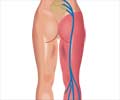A single injection may soon revolutionize the treatment of pain during and after surgery, thanks to a promising slow-release anesthetic drug-delivery system developed by researchers.
A single injection may soon revolutionize the treatment of pain during and after surgery, thanks to a promising slow-release anesthetic drug-delivery system developed by researchers.
During an NIH-funded study, the researchers at Children's Hospital Boston used specially designed fat-based particles called liposomes to package saxitoxin, a potent anesthetic, and produced long-lasting local anesthesia in rats.The team revealed that the procedure did not seem to leave any toxic effects on nerve or muscle cells.
"The idea was to have a single injection that could produce a nerve block lasting days, weeks, maybe even months," says Dr. Daniel Kohane, of the Division of Critical Care Medicine in the Department of Anesthesiology at Children's, and the report's senior author.
"It would be useful for conditions like chronic pain where, rather than use narcotics, which are systemic and pose a risk of addiction, you could just put that piece of the body to sleep, so to speak," he added.
Kohane and his colleagues have found that when saxitoxin is packaged within liposomes, it is able to block nerve transmission of pain without causing significant nerve or muscle damage.
The researchers evaluated various types of liposomes containing saxitoxin with or without dexamethasone, a potent steroid known to augment the action of encapsulated anesthetics. They found that the best liposomes produced nerve blocks lasting two days if they contained saxitoxin alone, and seven days if combined with dexamethasone.
Advertisement
The researchers even examined expression of four genes known to be associated with nerve injury, and found no up-regulation.
Advertisement
Kohane's team are presently trying to optimize the formulation so that their effects would last even longer.
"It is conceivable we could have a formulation that is suitable for clinical trials before too long," he says.
A research paper on their work has been published online by the Proceedings of the National Academy of Sciences.
Source-ANI
ARU














